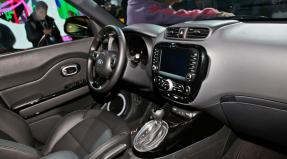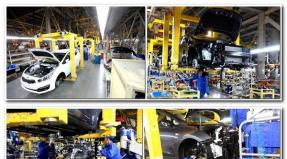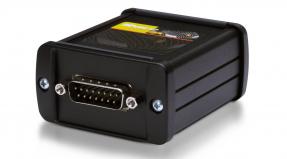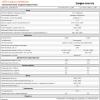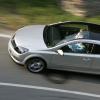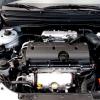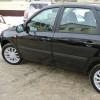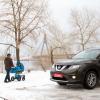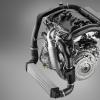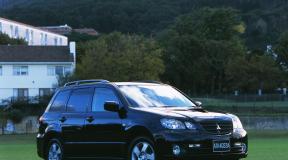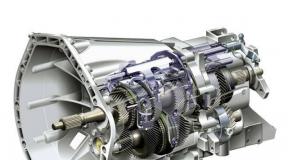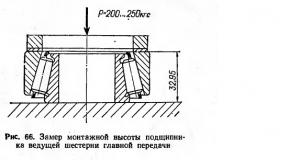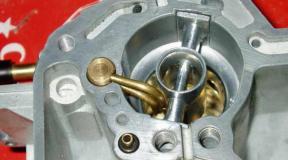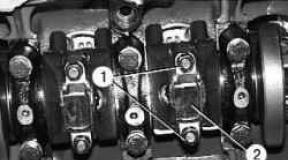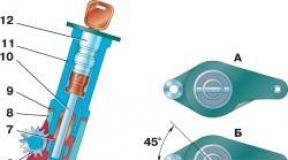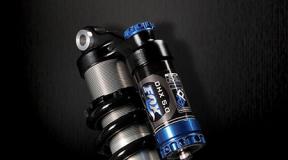Winter and summer parameters of pressure in Niva tires. Tire pressure for Chevrolet Niva according to passport Tire pressure for Chevrolet Niva table
Insufficient or overestimated tire pressure threatens premature failure of the chassis, the tires themselves, excessive fuel consumption, and most importantly, traffic safety. To test it, it is not enough to tap a boot, as shown in the old films. Visual inspection of the slope deformations is also not a sufficient evaluation criterion, although it serves as a signal to doubt the correctness of the pumping.
Instruments for checking the degree of pumping
For cars such as the Chevrolet Niva, maintaining this parameter is especially important. The center of gravity of this car is high and the car cannot be called stable, especially during emergency maneuvers. It is impossible to measure the degree of air compression in a tire without special measuring instruments.

For these purposes, manometers are used. They are divided into two categories, which differ structurally:
- Mechanical pressure gauge. A device for measuring tire pressure with a mechanical drive and dial indicator. Has a significant degree of error, long service life, does not require a power source.
- Electronic pressure gauge. An electronic device with a screen for displaying measurement data. Powered by an internal power supply, when used correctly, the error tends to zero.
Important: The error of devices of the first type in winter is greater than in summer due to temperature deformations of mechanical parts. In cold weather, it is recommended to use it only to get to the garage or service station. The disadvantage of electronic pressure gauges is the ability of the battery to sit down at the most inopportune moment.

Frequency of measurement on a Chevrolet Niva
In order not to expose your life and the lives of others, you need to check the tire pressure before every trip, especially over long distances. The sequence of actions is as follows:
- We check the readings using a pressure gauge as indicated in the instructions for it. Tires should not be hot. The car should stand for three hours.
- We compare the readings with the data in the table of permissible tire pressure for the Niva 21214 car.
- After 30-40 minutes, we repeat the measurement, and if the readings become low, then there is a puncture. Keeping the data at the same level indicates that it is possible to move out.
Recommendation: After the end of the trip, 2.5-3 hours later, another measurement is made. This requirement is optional. However, when driving the next day, you will not receive a deflated ramp surprise. All wheels are checked, including the spare.

What pressure should the Niva tires be?
To always know which pressure gauge readings are considered normal, print out a table of acceptable readings, and carry it in the glove compartment (if the metal plate on the car body is missing or has become unusable), and the pressure gauge in the trunk. In the cold season, the road surface is slippery and the rubber is less elastic. Therefore, in winter, the tire pressure should be lower than in summer. The allowable run is 0.2-0.3 bar.
This increases the contact patch area and increases the grip. The standard pressure in the Chevrolet Niva tires depends on the parameters of the ramp indicated on its sides. The table shows data for 205/75 R15, 205/70 R15 and 215/65 R16. These data are identical for the Chevrolet Niva 21214 and Niva 21213 models. In some emergency cases, it is allowed to make the injection rate lower than the recommended one.

So, the pressure in the tires of the Niva Chevrolet in winter can be reduced to 1.2-1.5 atm. If you are stuck in the snow. This will allow you to get out, but immediately after leaving on solid ground, the indicators should be brought to normal. The Chevrolet Niva, although an SUV, is not an all-terrain vehicle, and can get stuck not only in winter. How much pressure to set depends on the type, as well as the degree of wear of the tread.
Consequence of violation of standard pressure Niva 21213
If you do not adhere to the described operating requirements, the following will happen:
- The increased load on the undercarriage parts will lead to premature wear and failure.
- Fuel consumption will increase as the flat tire has a larger contact area. The tread, when opened, impedes movement. The engine will need to develop a lot of power.
- Tires will wear off quickly. The reason for this is the increased contact area with the road surface. By the way, lateral abrasion indicates that the wheel is flat, and an urgent need to measure and eliminate the cause.
- The risk of getting into an accident increases significantly, especially if you pump the wheels in winter.
But if you monitor the amount of air in the slopes, the Chevrolet Niva will always remain a safe car with outstanding cross-country characteristics.
Reducing fuel consumption, reducing tire wear, which will lead to unnecessary spending on new ones, is possible by setting the correct tire pressure. Therefore, constant monitoring of tire pressure will save you from these negative consequences, but also ensure safe driving on the roads. Below is a table where it is indicated what pressure should be:
Best of all, in this matter, you will be helped by the manual that comes with the purchase. We recommend that before long trips, as well as once every two weeks, check the tire pressure in the Chevrolet Niva, as well as in the tire itself, if the level is low, then the wheel should be pumped up, this can be done both by yourself and in a specialized tire service.
For the accuracy of the readings, it is necessary to do this as follows:
- Tires need to be warmed up
- Before measuring, the car must be at rest, or at least drive no more than one and a half kilometers
- Measurement should be carried out on all wheels including the spare
The consequences of improper paging
If the tire is flat or the norm is lower than the prescribed rate, more fuel will be consumed, and this also leads to wear of the tire itself, which can lead to undesirable consequences, for example, the stability of the machine may deteriorate, or there will be rapid tread wear in the center of the tire, the chance of that the tire will simply burst, that the movement in time can provoke an accident.

You should also pay attention to the pressure during the transport of heavy loads, it must be increased to compensate for the load on them. You can find out what it should be, guided by a special manual, or from the table above, as well as on most Niva cars, this information is on the driver's door.
Your safety on the roads while driving a car directly depends on how correct it will be. Therefore, such elementary rules as regular monitoring should not be neglected.
The importance of maintaining the correct tire pressure for the Chevrolet Niva is one of the parameters most underestimated by car owners. This is important because the pressure maintains a range of performance characteristics:
- stability of car control;
- ride stability;
- braking distance within the calculated one;
- preset trajectory of movement;
- uniform wear of the treadmill, due to which the operating life of the tires is kept at the proper level;
- the integrity of the side surfaces;
- the volume of fuel consumption, not higher than specified in production.
In the case of off-road driving, factory recommendations allow a decrease in the indicator to one and a half bar. In some cases, car owners themselves increase the pressure for driving on the highway to 2 or 2.2 bar. The manufacturer points out that pressures above two make the ride harder and less comfortable.
Methods and frequency of measurement of air pressure in tires Chevrolet Niva
Tire pressure is measured using special devices and at specified intervals. The main measuring device is a pressure gauge. There are two categories of this device:
- mechanical;
- electronic.
The first are distinguished by the fact that they have a mechanical drive in combination with a dial indicator. The disadvantage is a fairly high level of error, which grows in the cold season. This is due to thermal deformation. In connection with it, mechanical pressure gauges are used in the cold only as an auxiliary tool until there is an opportunity to visit the service station. But this disadvantage is balanced by the length of the operating period and the lack of the need for a power source.

The second category of devices is powered by a battery that is charged through a network connection. The main drawback lies in the ability of the battery to sit down at the most inopportune moment. Due to a more complex device, such a pressure gauge has a minimum error. The data is displayed on a screen similar to the display of other electronic devices.
Checking the tire pressure before each long trip is a mandatory item of measures to ensure safe operation vehicle... They do the actions necessary for this in a certain sequence:
- let the car stand for at least three hours;
- check that the tires are cold;
- connect a pressure gauge and take measurements as indicated in the instructions for it;
- check the result with the table of acceptable values;
- recheck the data after a half-hour pause.
An indication of the presence of a puncture will be a decrease in readings between two measurements. The absence of any changes indicates that the situation is normal.
Experts recommend checking the pressure after driving. This must be done two and a half or three hours after stopping. Thanks to this additional measurement, it is possible to exclude the possibility of a puncture formed during the trip. It is necessary to measure data not only on the installed rubber, but also on the one that is used as a spare.

What pressure in the tires of a Chevrolet Niva car should be
Normal tire pressures for tires installed on a Chevrolet Niva crossover depend on tire sizes, weather conditions and the type of road surface. On the body of many stock copies, you can find special metal plates, where data on normal pressure is indicated. But, if it is not there, then you should print a similar table and carry it with you. A pressure gauge is a must in the trunk of every car owner.
The main differences for rubber of the same standard size are associated with the time of year when it is used. So, in winter, the piste surface is often rather slippery. At the same time, the elasticity of the rubber increases. This results in a pressure drop of 0.2 or 0.3 bar allowed. Lower indices of intra-tire pressure allow to increase the contact patch of the tire with the road, which has a positive effect on the quality of grip.
The pressure in the tires is made below the recommended level in case of extreme off-road conditions or if the car is stuck in the snow. In the second case, a decrease is permissible up to 1.2 atmospheres. Thanks to such a small injection, it will be easier for the Chevy to go to hard surface, but as soon as this happens, the pressure must be brought to normal for this time of year. If the car is stuck off-road, then for mud tires, when setting the required pressure level, tread wear is also taken into account.
Tire pressure table for Chevrolet Niva in winter and summer
It is mandatory to regulate the pressure of all cars that have stood motionless for more than half an hour in the summer or a quarter of an hour in winter conditions. In the latter case, the frequency is also influenced by the reading of the thermometer - the lower it is, the more often it is necessary to check. Heating the air for every eight degrees adds 0.1 atmospheres to the required pressure.| Diameter | Standard size | Recommended pressure |
| R15 | 205/70 95T | 1,9 |
| 205/70 95Q M + S | 1,9 | |
| 205/75 97T | 1,9 | |
| 205/75 97Q M + S | 1,9 | |
| 215/75 100Q | 1,8 | |
| R16 | 215/65 98H | 1,9 |
| 215/65 98Q M + S | 1,9 |
Road conditions significantly affect the permissible values in deviation from the recommended pressure indicated in the table for various tire radii. So, if the Niva Chevy rides through mud or loose snow, then the optimal solution will be in the form of a decrease to 1.2-1.5 atmospheres. But it should be borne in mind that such a low pressure at the wheel can lead to its disassembly. Therefore, the ride should be relatively smooth, without sudden jerks.
A suitable value for ice is considered to be 1.7 atmospheres, while on dry asphalt in good weather, it is often driven at 2 atmospheres. But an increase in the rate can lead to discomfort. It is justified if you have to ride on a surface strewn with stones - in this case, an indicator of two and a half bars may be suitable.
All season tires
Designed for use in any weather, it is therefore important to take into account that different conditions require different pressures. Initially, the atmospheric indicators in such tires correspond to the average recommended. At the same time, the car owner is required to regularly monitor that the pressure level is suitable for the operating conditions.
Off-road wheels

Federal Couragia M / T or BF Goodrich originally refers to tires low pressure... This allows them to overcome problem areas with maximum grip. At the same time, its level can be reduced down to 0.8 atmospheres, if conditions so require. But for driving on a hard surface, maximum pumping is necessary.
Niva Chevrolet on low pressure wheels
These tires have a slightly flattened shape. This allows a large area of rubber to come into contact with the road surface, which contributes to increased grip. Therefore, such wheels are installed on the Chevy if they want to turn it into an all-terrain vehicle and achieve passage on any off-road.
The main issue that is being resolved at the same time is maintaining the rigidity of the structure in combination with a decrease in the specific weight of the car on the wheelbase. Otherwise, when passing through difficult sections, the Niva runs the risk of falling apart. Hence the requirement to have some dexterity when driving a vehicle with such rubber. It should be borne in mind that the all-terrain vehicle does not drive very quickly and does not enter turns at high speed.
The owner of the Chevrolet Niva on low-pressure tires receives in addition off-road and a number of other advantages:
- a higher level of adhesion to any surface;
- the most sparing attitude to the upper soil layer, due to which it is suitable for agricultural work and conservation;
- the minimum probability of an accident due to the fault of a car with such tires.
Of course, for such advantages you have to pay with a minus in the form of a decrease in speed. In addition, the car will have to be re-registered from a passenger car to an all-terrain vehicle.
You can learn how Chevy on such rubber is able to overcome off-road terrain from the video.
Consequences of incorrect tire pressure
Neglecting the pressure in the wheels of the Chevrolet Niva can lead to a number of negative consequences for both the car itself and its owner. The most significant of them:
- premature wear of the running gear with the inevitable failure of one or another of its parts - caused by increased load;
- if the pressure is too low, the fuel consumption increases, which directly depends on the contact area of the rubber with the road;
- an overly expanded protector does not allow the car to move normally;
- to overcome an obstacle, the motor is forced to develop more power;
- if the pressure is too high, then due to poor adhesion, the risk of getting into an accident increases;
- lateral tire wear due to flat tires;
- accelerated wear of a tire on a hard surface is the result of reduced pressure.
Timely adjustment of the pressure level will help to avoid all these problems, in accordance with the recommendations specified in this article.
Let's continue the topic of winter tires and their correct operation. Of course, you know that in order for the tires to serve as long as possible, you need to monitor the pressure. Moreover, in winter and summer, you need to swing it in different ways. Why? Let's figure it out now. Moreover, comfort, safety, speed of tire wear and much more depend on the degree of tire inflation. In winter, we are primarily interested in safety - we'll talk about it. With the right pressure with tires, we can increase safety on the winter road. A winter road is ten times more dangerous than a summer one.
I will not talk about the summer, there are some nuances of pumping the wheels. Consider the winter period.
The winter tire is very different from the summer one, it is completely cut with lamellas - Velcro, whose task is to "open up" under the weight of the car and stick to the ice and icy surface. Even a studded tire will have sipes.
That is why, in order to increase the ice contact patch, the wheels should be inflated slightly less than usual. The lowered wheels flatten under the weight of the car more, the contact patch is larger, the Velcro “opens up” more and the tire adheres perfectly to the hard surface. This applies to ice, icy asphalt.
Likewise, a flat tire is excellent at digging loose snow. By analogy with how uazovody "poison" tires off-road - they lower them to 1 atmosphere and even lower (depending on the strength of the sidewall of the tire and its softness), the contact patch with dirt increases and the permeability increases.
However, consider this option - the tire is studded and very soft. You pumped it lighter, in the snow, crust - just gorgeous. And suddenly she began to slip on the ice. What happened? There are situations (it depends on the quality of the studding, the composition of the rubber compound), when the studs are pressed into the tire on a soft tire. And if you also pumped it up lighter, then it turns out that the spikes are inside the tire all the time, only the extreme ones are sensitive, while the central ones are almost always inside. Therefore, you need to keep this nuance in mind.
However, all the same, the general tendency is as follows - in winter we pump the tires more relaxed. On the internet there are pressure tables for each brand of car (what is for winter, what is for summer), you can find out for your own. I'll tell you about the Chevrolet Niva. In the photo, my all-season mud (more complete review):
In winter, on Shevik, I always swing 1.7 on all wheels, when there is strong ice on the roads, I lower it to 1.5 in general. The velcro I have is soft and sticks to the ice quite well, but when it is still lowered, it keeps it generally normal.
I will not touch on the question of "tires or Velcro" here either, and so everyone understands that spikes are preferable, but all the same, first of all, the choice depends on the conditions and places of use. A million-plus city, where in winter there is almost always bare asphalt - linden will steer. A small northern town where roads are swept away and ice is everywhere - thorns rule.
Watch not only your pressure :-), but also the pressure in the wheels of your car, your life and the lives of your passengers and other participants depend on it road traffic... Don't dash on a winter road, it's not worth it. You can always drive in the summer, if you don't have the strength to drive normally)) Well, buy a normal one winter tires, if you do not have one yet and you hope at random. Like, I'll go one more winter season on this inferior rubber, and then I'll buy a normal one. "Then" may not come. Live in the here and now. Well, good luck on the road, not a nail or a rod, as they say.
The pressure in the tires of any car is not just a guarantee of a comfortable ride. Observance of the correct air value in the tires of any vehicle is, first of all, safety on the road for the driver and passengers.
Also, incorrect tire pressure can cause disturbances in the operation of the entire chassis and wheelbase of the vehicle. Therefore, this indicator should be monitored regularly. Next, we will consider how this should be done on a Chevrolet Niva car, and what the consequences of incorrect indicators are fraught with.
 Car tire pressure monitoring
Car tire pressure monitoring Metering methods
It is impossible to determine the amount of air in tires without special devices. Outwardly, it turns out to notice only some deformations, the cause of which was wrong pressure... As a result of this, a certain depression may appear on the rubber itself, and the tread pattern may change.
It is possible to measure the tire pressure on the "Chevrolet Niva" only with the help of pressure gauges. In total, there are two types of such devices:
- mechanical (switch);
- electronic.
 Electronic pressure gauge for auto
Electronic pressure gauge for auto The percentage of error in mechanical pressure gauges is higher, but not significant. In everyday life, they can be used with the same success as electronic counterparts. The most accurate result is given by electrical pressure gauges. The error indicator in this case is no more than 0.05 bar. Today it is the most accurate device for measuring tire pressure not only on the "Niva", but also on other cars.
It should also be noted that in winter the tire pressure level can be measured more or less accurately only with an electronic pressure gauge.
Frequency of measurements
It is necessary to take readings of the pressure level once a month, subject to the active operation of the car. If you plan to travel a long distance, you should make a control measurement before the start of movement and after 3 hours after the final cessation of the movement of the vehicle.
Features of pumping in winter
Since in winter the grip patch of the tire should be slightly larger than in summer, you should slightly reduce the pressure in the wheels of your Niva 2121 or 21214. This is due to the fact that the road surface is most often covered with ice. The larger the adhesion area, the lower the risk of an accident. Under the weight of the car, the tire "sags", the tread opens more, which ensures tight grip of the wheel even with bare ice and at high speed.
 Standard pressure in tires of cars Niva 2121 and 21214
Standard pressure in tires of cars Niva 2121 and 21214 Relieve pressure correctly
For the readings to be accurate, the pressure must be relieved correctly. This should be done in this way:
- the tires must be cold;
- the last 3 hours before the measurement, the car must be at rest or drive no more than 1.5 kilometers;
- measurements must be taken on all four wheels and a spare tire.
Only in this case, the readings from the manometer can be considered correct.
Table of values of the required level of pressure in tires for "Chevrolet Niva":
The pressure standards in the wheels of the "Niva" 2121 or 21214 must be indicated on a special metal plate. Typically, it is attached to the door from the driver's seat. If there is none for some reason, you can view the data on the network. But in this case, it is better to take into account the readings only approximately.
You should also pay attention to the fact that the amount of air in the rear tires should be somewhere between 0.3-0.5 bar more. This is due to the fact that the load on the rear axle of the wheel is always greater than on the front.
 Car tire pressure check
Car tire pressure check The consequences of improper pressure
In addition, if the pressure is incorrect, the chassis and the wheelbase of the Niva 2121 or 21214 are destroyed. Such negative factors may also arise:
- fuel consumption will increase significantly (by an average of 1.5-2 liters);
- deformation of tires will occur;
- there will be a possibility that the tire will burst during the movement, which can lead to an accident.
All these negative factors can be avoided by timely measuring the pressure in the Niva 21214 or 2121. By the way, this applies to any vehicle.
Your safety on the road while driving depends on the pressure in the tires of your "Niva" 2121. Therefore, you should not neglect such checks - they need to be carried out regularly (independently or at a service station).
In addition, in addition to safety while driving, if the tire pressure standards are not observed, the chassis of the vehicle and the wheelbase wears out much faster.
